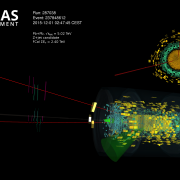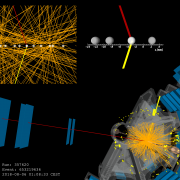Access to Collaboration Site and Physics Results

This week, physicists from around the world are gathering at the Top 2015 workshop in Ischia, Italy to discuss the latest measurements of the top quark. As the heaviest known fundamental particle, the top quark plays a special role in the search for "new physics". In results presented at Top 2015, the ATLAS collaboration combed through their high-precision Run 1 LHC data to see if the top quark is behaving as predicted by the Standard Model of particle physics. ATLAS also presented new measurements of top-quark production at high-energy (13 TeV) from early analyses of the ongoing Run 2 of the LHC.
The LHC produces large numbers of top quarks in pairs through the strong force. Quantum chromodynamics, the theory that describes the strong force, predicts the energy and momentum distributions of these events. However, physics beyond the Standard Model could result in more top quarks at very high momentum, for example. Two new ATLAS results have measured the distribution of the top quarks recorded in the 8 TeV data and have seen top quarks with more than 1 TeV of transverse momentum. These measurements agree with the predictions of quantum chromodynamics, so the strong force works as expected at such high energies.

Top quarks can also be produced on their own through the Standard Model's weak interaction. Such processes are rarer than the production of top quark pairs and a particularly rare one is the 's-channel' process, which had yet to be seen at the LHC. In a new result, ATLAS has found first evidence at the LHC of single top quark production in the s-channel, where the top quark is produced along with one b-quark.
Events containing single top quarks are difficult to single out from other ("background") events produced in the collisions. ATLAS employs a sophisticated technique that uses the measured energies and momenta of the particles in the detector to determine if an event is likely to be from single top quark production or from background processes. In the Run 1 data, ATLAS has determined around 500 events to originate from s-channel single top production. The probability that those events are instead from background processes has been estimated to be less than 0.3%.
ATLAS has found first evidence at the LHC of single top quark production in the s-channel, where the top quark is produced along with one b-quark.
The top quark is so heavy that it could in principle decay into other heavy particles that have smaller mass, including the Z boson and the Higgs boson. In the Standard Model, these decays are highly suppressed. However, in "new physics" models such decays may happen, albeit with a very small probability. Using the millions of top quark events collected during Run 1, ATLAS has searched for the top quark decaying into either a Higgs boson or a Z boson.

The searches are able to see the rare decays, even if only one top quark in 1000 decayed to a Z boson or three top quarks in 1000 decayed into a Higgs boson! So far the data have not shown any evidence of these decays, but the data currently being collected at 13 TeV will allow ATLAS to look for even rarer decays.
In all the results produced so far the top quark has behaved as predicted by the Standard Model. This fascinating particle will be measured in greater detail using the new high energy data that ATLAS is currently collecting.
Links
1. For the full collection of ATLAS Run 2 results, click here.
2. For all ATLAS top physics public results, click here.
3. Public paper on arXiv: "Search for flavour-changing neutral current top-quark decays to qZ in proton-proton collision data collected with the ATLAS detector at 8 TeV"
4. Conference note: "Evidence for single top-quark production in the s-channel in proton-proton collisions at 8 TeV with the ATLAS detector using the Matrix Element Method"
5. Conference note: "Measurements of the tt production cross-section in the dilepton and lepton-plus-jets channels and of the ratio of the tt and Z boson cross-sections in proton-proton collisions at 13 TeV with the ATLAS detector"








